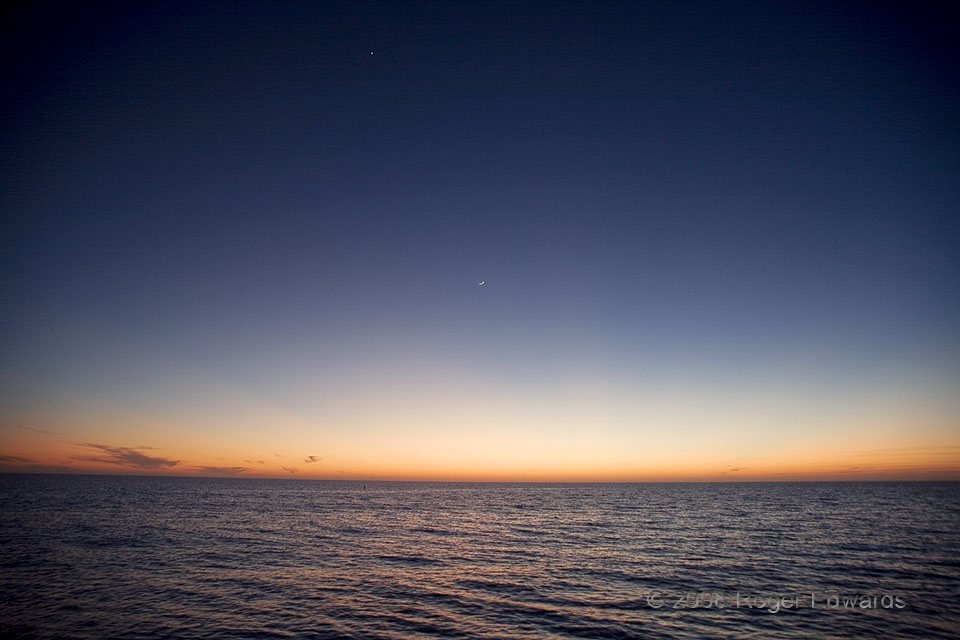 Between sunset and nightfall passes the period known as twilight, a period of illumination long subject to rumination by poets and romantics the world over. Its morning counterpart has the same name. Twilight has varying stages, the first ending with civil dusk (sun 6° under horizon). Even with the sun well below the horizon, sunlight is be scattered through the upper atmosphere to some extent, and is enough to outline faint objects on the ground through nautical dusk (sun 12° below horizon). Although residual sunlight typically can’t be seen anymore with the naked eye in the third stage, enough is scattered to hinder ideal telescopy of faint objects until astronomical dusk (sun 18° under). Then comes nighttime by every commonly used definition. Here, even in a sweeping wide-angle view, the moon (middle) and Venus (upper left) can be seen decorating the evening sky over the eastern Gulf of Mexico, somewhere around the end of civil twilight, with faint crepuscular rays still visible.
Sanibel FL (29 Dec 8) Looking WSW
26.4498, -82.1426
Between sunset and nightfall passes the period known as twilight, a period of illumination long subject to rumination by poets and romantics the world over. Its morning counterpart has the same name. Twilight has varying stages, the first ending with civil dusk (sun 6° under horizon). Even with the sun well below the horizon, sunlight is be scattered through the upper atmosphere to some extent, and is enough to outline faint objects on the ground through nautical dusk (sun 12° below horizon). Although residual sunlight typically can’t be seen anymore with the naked eye in the third stage, enough is scattered to hinder ideal telescopy of faint objects until astronomical dusk (sun 18° under). Then comes nighttime by every commonly used definition. Here, even in a sweeping wide-angle view, the moon (middle) and Venus (upper left) can be seen decorating the evening sky over the eastern Gulf of Mexico, somewhere around the end of civil twilight, with faint crepuscular rays still visible.
Sanibel FL (29 Dec 8) Looking WSW
26.4498, -82.1426
Twilight
 Between sunset and nightfall passes the period known as twilight, a period of illumination long subject to rumination by poets and romantics the world over. Its morning counterpart has the same name. Twilight has varying stages, the first ending with civil dusk (sun 6° under horizon). Even with the sun well below the horizon, sunlight is be scattered through the upper atmosphere to some extent, and is enough to outline faint objects on the ground through nautical dusk (sun 12° below horizon). Although residual sunlight typically can’t be seen anymore with the naked eye in the third stage, enough is scattered to hinder ideal telescopy of faint objects until astronomical dusk (sun 18° under). Then comes nighttime by every commonly used definition. Here, even in a sweeping wide-angle view, the moon (middle) and Venus (upper left) can be seen decorating the evening sky over the eastern Gulf of Mexico, somewhere around the end of civil twilight, with faint crepuscular rays still visible.
Sanibel FL (29 Dec 8) Looking WSW
26.4498, -82.1426
Between sunset and nightfall passes the period known as twilight, a period of illumination long subject to rumination by poets and romantics the world over. Its morning counterpart has the same name. Twilight has varying stages, the first ending with civil dusk (sun 6° under horizon). Even with the sun well below the horizon, sunlight is be scattered through the upper atmosphere to some extent, and is enough to outline faint objects on the ground through nautical dusk (sun 12° below horizon). Although residual sunlight typically can’t be seen anymore with the naked eye in the third stage, enough is scattered to hinder ideal telescopy of faint objects until astronomical dusk (sun 18° under). Then comes nighttime by every commonly used definition. Here, even in a sweeping wide-angle view, the moon (middle) and Venus (upper left) can be seen decorating the evening sky over the eastern Gulf of Mexico, somewhere around the end of civil twilight, with faint crepuscular rays still visible.
Sanibel FL (29 Dec 8) Looking WSW
26.4498, -82.1426